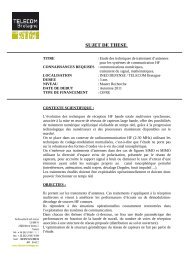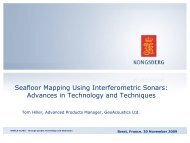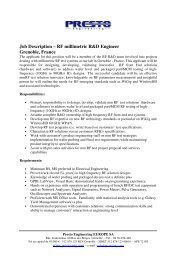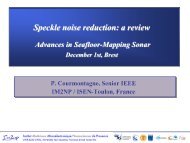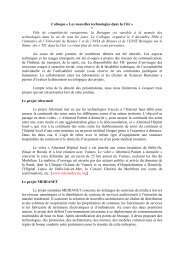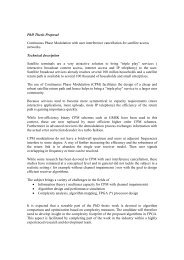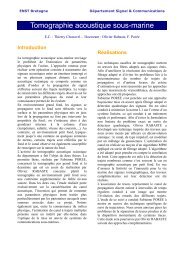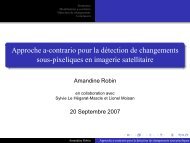Département Réseau, Sécurité et Multimédia Rapport d'Activités 2008
Département Réseau, Sécurité et Multimédia Rapport d'Activités 2008
Département Réseau, Sécurité et Multimédia Rapport d'Activités 2008
Create successful ePaper yourself
Turn your PDF publications into a flip-book with our unique Google optimized e-Paper software.
<strong>et</strong>ween the number of sink nodes and th<strong>et</strong>otal number of nodes in the n<strong>et</strong>work.Figure 1. Pattern of sensor and sink nodesWhen a message reaches a given sensor node,the next hop occurs uniformly at random onlyto the nearest-neighbors. Thus, in the case of4-connectivity all the 4 nearest-neighbors awayfrom the current sensor node are equally likelywith transition probability 1/4. A messagegenerated at a given sensor node performsthen a random walk until it reaches for the firsttime a sink node where it will be trapped andnever leaves. At this moment, we consider thatthe data delivery process has been occurredwith success.There are many motivations that prompted usto choose this n<strong>et</strong>work structure. First, manyWSN applications are often desired to followregular patterns for at least two reasons: (i)convenience of deployment and (ii) to achievea higher degree of connectivity and coverage.Second, this division of the n<strong>et</strong>work into unitcells suggests a very natural way of groupingnodes tog<strong>et</strong>her (clustering). Such a clusteringis often required by protocols in order to dealwith the large number of nodes. Third, it isnatural to start with regular patterns beforeaddressing more complex ones. Finally, thispattern is simple enough to allow a compl<strong>et</strong>eanalytical treatment of the random walktechnique while still being useful to incorporatespecific key issues of WSN such as theconnectivity and the coverage.To investigate the performance of theproposed data delivery based on the randomwalk techniques, we have exploited heavily inthis work the m<strong>et</strong>hod of generating functionsto derive insightful results. The main idea wasto characterize the random walk induced onthe n<strong>et</strong>work by d<strong>et</strong>ermining the generatingfunctions associated with node occupationprobabilities and first-passage probabilitiesrespectively. Once d<strong>et</strong>ermined, thesequantities enabled us to derive closed-formexpressions for some performance m<strong>et</strong>ricssuch as the expected delay required for amessage to be gathered by a sink node andthe energy cost incurred by this operation.These m<strong>et</strong>rics were expressed as a function ofthe key param<strong>et</strong>ers of the model. For example,the expected delay is found to be ~2N 2 Log(N)/. This can be put into practicaluse for WSN dimensioning with respect tocrucial param<strong>et</strong>ers such as the minimum ratioof sink nodes to be deployed over the totalnumber of sensor nodes while ensuring arequired level of performance. As regards tothe energy cost, the main result was that therandom walk techniques achieve a goodbalancing property and present no criticalpoints of failure compared to d<strong>et</strong>erministictechniques.ConclusionThere are several interesting directions thatmay extend the model presented in this work.This consists for instance in considering morecomplex topologies where sink nodes aredeployed at random or a constrained randomwalk to prevent messages from r<strong>et</strong>urn back tothe initial territory.References[1 D. Braginsky and D. Estrin. "Rumor RoutingAlgorithms for Sensor N<strong>et</strong>works." Firstinternational Workshop on Sensor N<strong>et</strong>worksand Applications (in conjunction with ACMMobiCom '02). pp. 22-31, 2002.[2] S. D. Serv<strong>et</strong>to, G. Barrenechea,Constrained random walks on random graphs:routing algorithms for large scale wirelesssensor n<strong>et</strong>works, in: Proc. of the 1st ACMinternational workshop on Wireless sensorn<strong>et</strong>works and applications, ACM Press, NY,USA, 2002, pp. 12–21.[3] H. Scher, M. Lax, Stochastic Transport in aDisordered Solid. I. Theory, Phys. Rev. B 7(10) (1973) 4491–4502.Pracom’s Annual Report <strong>2008</strong> 11




